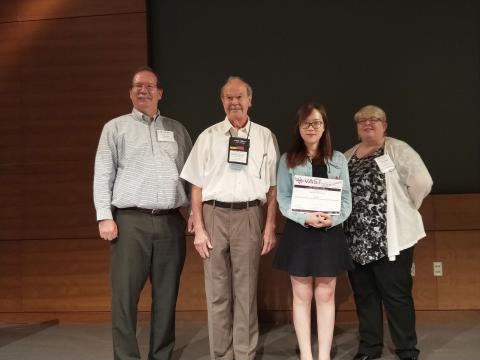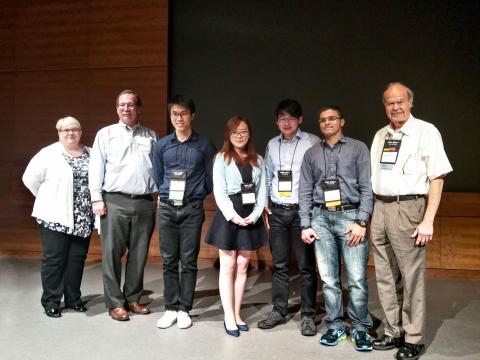
Team JKY from the Master of IT in Business (MITB) programme performed positively at the IEEE Visual Analytics Science and Technology (VAST) Challenge 2017. Comprising Jason Ong, Kishan Shridhar and Zhang Yanrong, Team JKY secured an award for their submission to the prestigious competition, winning for “Clear presentation of hypotheses and supporting evidence”. MITB classmate Guan Yifei won an individual award for "Actionable and Detailed Analysis" as well.
The Visual Analytics Science and Technology Challenge (VAST Challenge) is an annual competition with a goal of advancing the field of visual analytics and discovery through competition. In terms of the judging process, submissions were evaluated based on a peer review process that recommended outstanding submissions for award considerations. This was done by subject matter experts in the visual analytics community. Instead of conventional rankings of first place and runner-up, teams were awarded based on exemplary performance in a specific field. The experts identified the aspect of the submission deemed worthy of recognition and awarded the team a title such as “Clear presentation of hypotheses and supporting evidence”.
This year, the competition involved a series of three mini challenges and a grand challenge, which researchers and students in the field of visual analytics were invited to solve. The challenge required the application of visual analytical tools and approaches to help solve a mystery in a wildlife preserve. Participants were given a scenario where the rose-crested blue pipit (a type of bird) has been disappearing from the preserve and has faced a steadily decreasing count over the years. Datasets relating to three scenarios which might be affecting the bird species were released, and the challenge was to discover insights that lead to discoveries of striking patterns or anomalies. There were three datasets, each released for the corresponding mini challenges, dealing respectively with traffic patterns of vehicles moving inside the preserve (Mini Challenge 1), chemical emissions from factories which are located proximal to the preserve (Mini Challenge 2) and satellite imagery data of the entire preserve (Mini Challenge 3).
The Grand Challenge involved stitching together the insights from all the three mini challenges into a coherent story and a well-defined hypothesis. Participants submitting for the Grand Challenge needed to solve the three individual mini challenges to be eligible for submitting to the Grand Challenge.

Judges were impressed by how participants from a seemingly business-centric university (based on their assumptions of the name “Management University”) could perform equally well in a scientific visualisation competition when compared with participants from other technological/science centric universities or research labs. They commended SMU’s MITB teams who were able to inject business elements into scientific research to make insights more actionable.
Team JKY wowed the judges with a clear presentation of hypotheses and supporting evidence for the submissions made for the Grand Challenge. Commenting on the team’s approach towards the challenge, Kishan commented: “Solving the Grand Challenge was a combined effort, as it also involved analysis of textual facts to stitch together a coherent story. The submission was well received by the organiser, who particularly thanked both our teams for travelling all the way to the conference, and was delighted by the responses we had prepared for the challenge. The responses are now part of the benchmark repository they will maintain over the years.”
Tackling each mini challenge methodically, Team JKY came together to deliver on the Grand Challenge, competing against 53 shortlisted teams. The team members were unanimous in their views that the competition encouraged lateral thinking as it needed perspectives from three different dimensions from each of the individual challenges. It also involved analysis of textual data and information from newsletters, enabling members to don the role of visual detectives to solve a mystery.

“Besides knowledge discovery in the form of learning new visual analytics tools and software such as Tableau, QGIS, Visio, etc. the project enabled coherent teamwork. With the amalgamation of the three mini challenges, it was possible to reveal a greater picture and establish links between various scenarios in this case,” said Jason.
Team JKY attributed its success to the invaluable guidance of professors at SMU. Expressing his appreciation, Yanrong shared, “I feel very excited with the experience we had at the IEEE VIS Conference. All excellent scholars and students shared their research progress and output. For our JKY team, we are very proud of what we have done, and I believe that Prof. Kam Tin Seong will be proud of us too. What we submitted to the challenge was an assignment within Prof Kam’s Course- Visual Analytics (B.6). And it’s hard for me to remember how many times we consulted with him. Thanks to Prof Kam and thanks to SMU for offering us this good platform and opportunity.”
The challenge proved to be a valuable experience which complemented their coursework. Sharing about their aspirations after the competition, Kishan said: “While attending the IEEE VIS Conference in Phoenix, Arizona to deliver our solution, we also had the chance to listen to other award winners at the event. There were a lot of learning points gathered from the various design approaches and the customised tools which certain participants had developed to tell the story of the challenge. We believe the challenge has given us a chance to prove our skills in visual analytical tools, lateral thinking and finally, greater confidence to deliver as a team in similar competitions.”
Having had an equally positive experience with the challenge, Yifei shared, “From the job descriptions posted by different companies we can see that more and more employers are looking for visualisation skills when they hire for data analysts/scientist and analytics consultants. My greatest takeaway from this competition as well as our Visual Analytics & Application module is that visualisation alone is not enough, what sets us apart is the ability to embed analytics into visualisations. Instead of simply assembling charts together, we need to think about how to present complex logics/analytics in the form of visually appealing outputs that allow users without technical backgrounds to comprehend easily. In my future careers I would like to adopt visual analytics whenever possible, and also to share its benefits with more people.”
Featured photo: (L-R) Zhang Yanrong, Kishan Shridhar and Jason Ong of Team JKY securing an award at the prestigious IEEE Visual Analytics Science and Technology (VAST) Challenge 2017, a proud first for SMU.